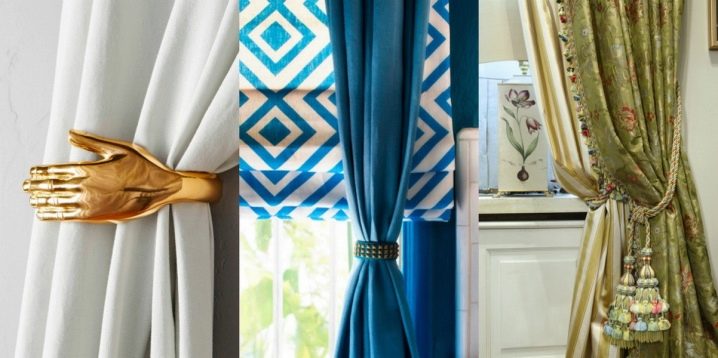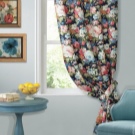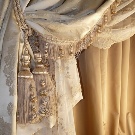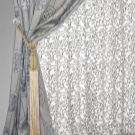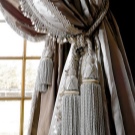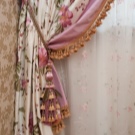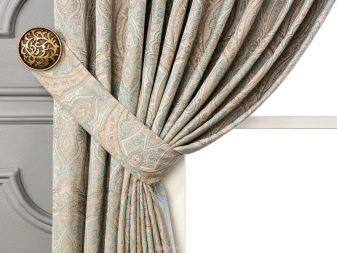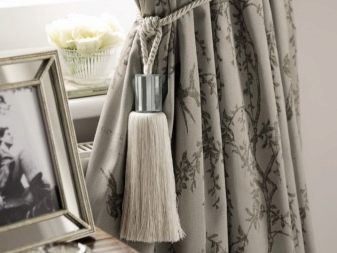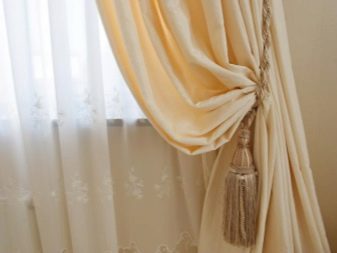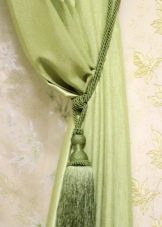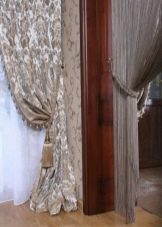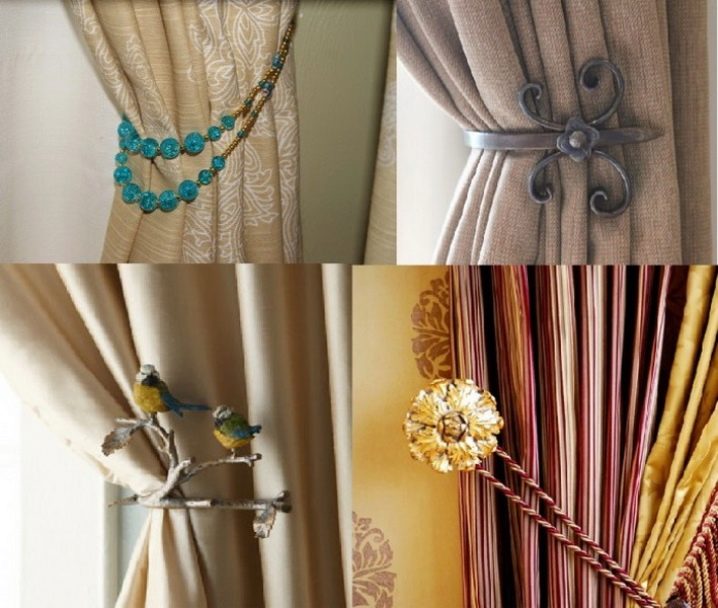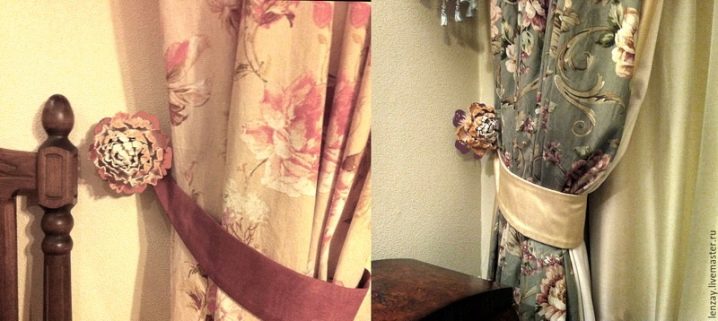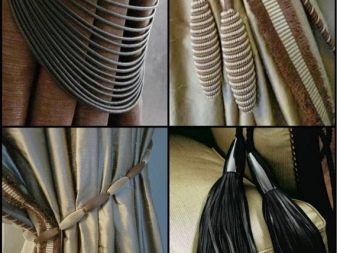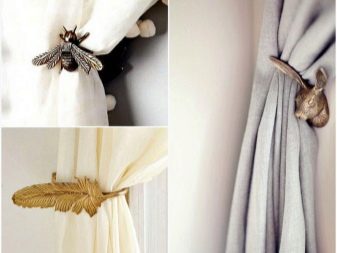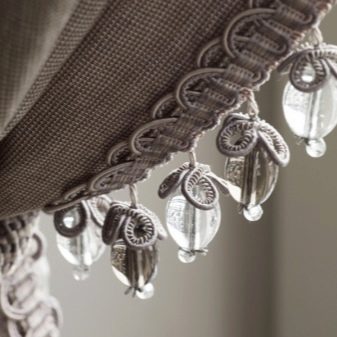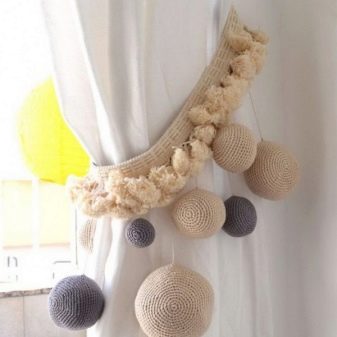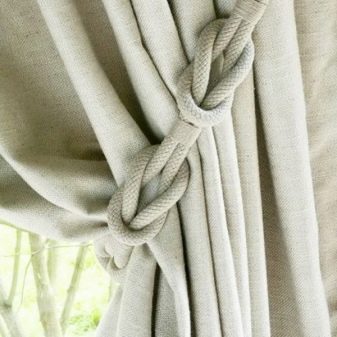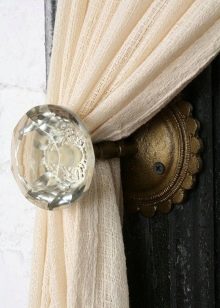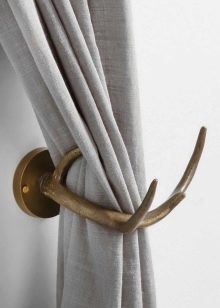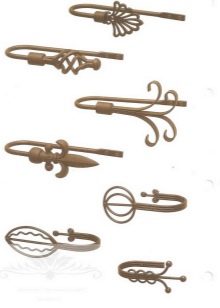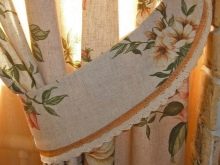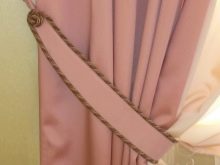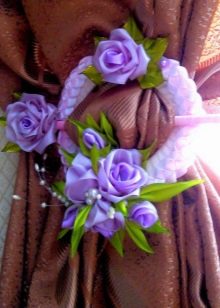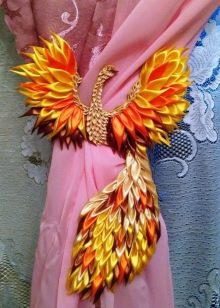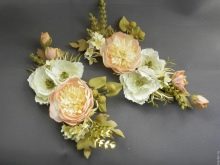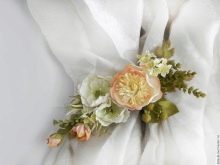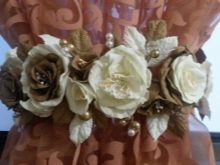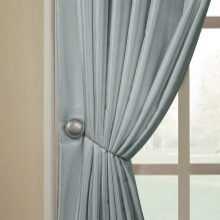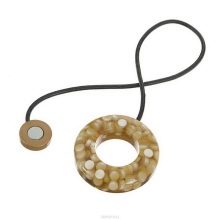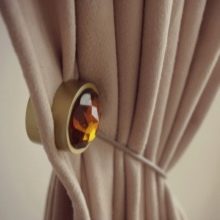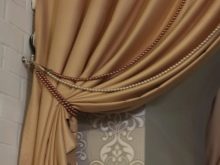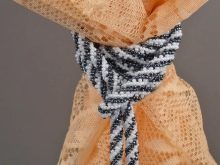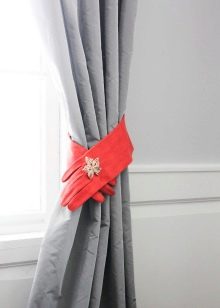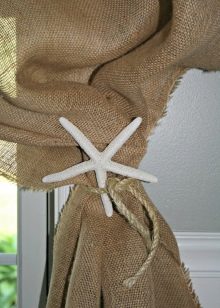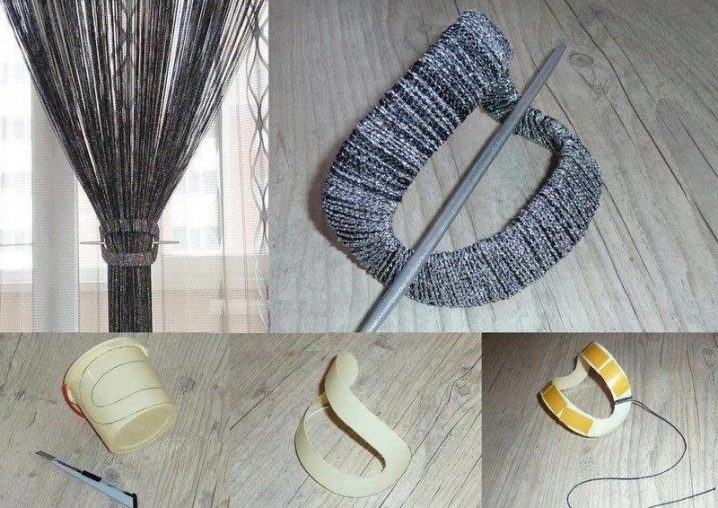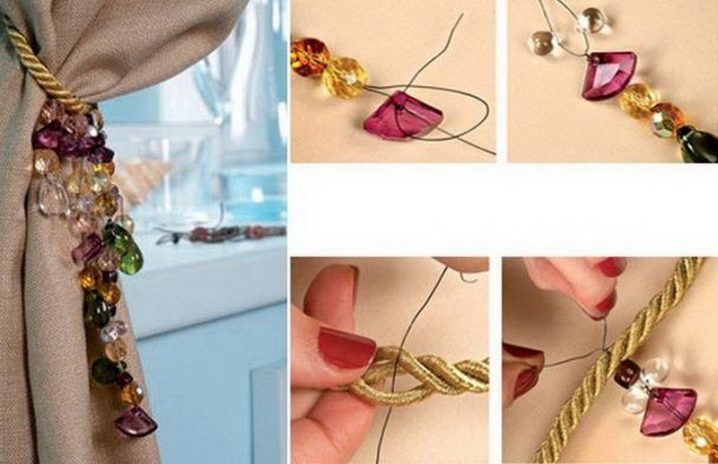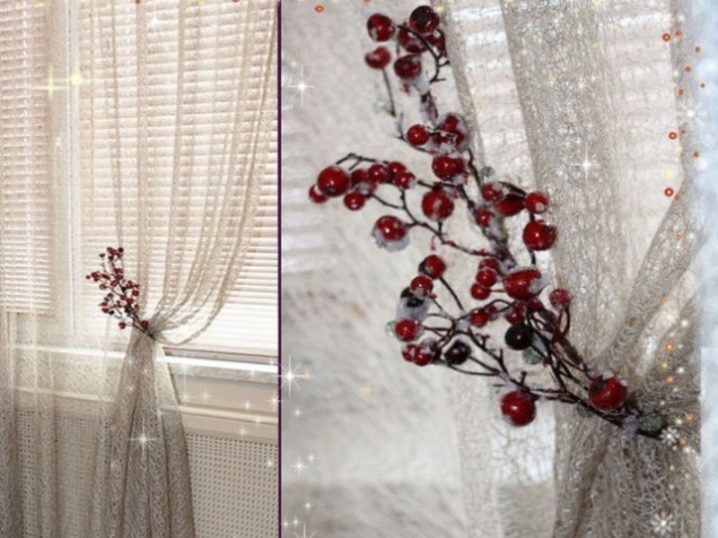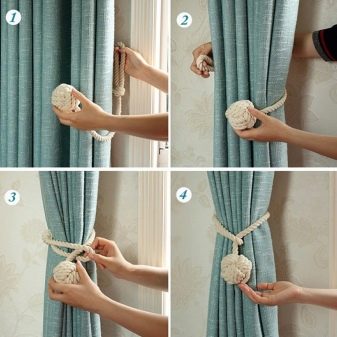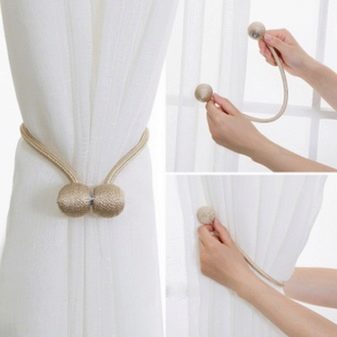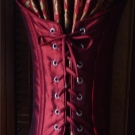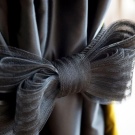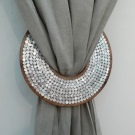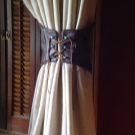Tiebacks for curtains: types, pros and cons, workshops, manufacturing and mounting methods
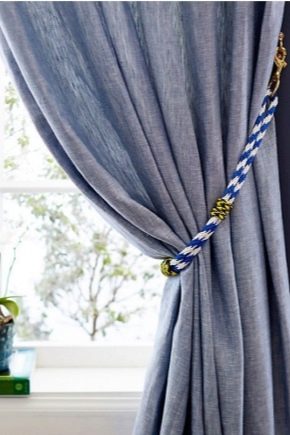
The finished look and comfort of any apartment give the curtains hung on the windows. Depending on the interior design and the size of the room, it can be both heavy velvet drapes and light, almost transparent organza. Whatever the fabric covering the window and part of the wall, it delays the penetration of the sun's rays inside. To let the light into the room, you can simply push the fabric sheets, giving him access. However, it will be more convenient to do this with a special pickup attached to the wall or on the curtain itself.Soft drapes, resulting from such anchoring, look aesthetically pleasing and give sophistication to even the simplest curtains.
Purpose
Tacks are an optional curtain element made from various materials. Their main function is to fix the tissue in a certain position and at a certain level. This is done for a number of reasons.
- Strengthening natural lighting at home. Spreading out and fixing in the right position the curtains allow the light to better penetrate through the window and scatter around the room.
- Decoration curtains and windows. Tacks also have an aesthetic function, they are capable of presenting a refined fabric of curtains in a winning light or hiding small flaws of tulle. With their help, you can adjust the proportions of both the window itself and the entire room.
- Preservation of strength and appearance of curtains. The less the curtains move and touch, the longer they stay clean and durable. It is enough to fix the washed and ironed curtains on the window with clips once and you can not worry about them until the next wash.
Properly selected latches offer many advantages to even the simplest curtains. Not only do they simplify the process of interaction with curtains, but also allow you to bring a highlight even in the most boring interior. Curtains with grabs are hung not only on the windows. With their help, make out the various arches and passages. In recent years, decorative drapery is often used for decoration of various celebrations, such as anniversaries or weddings. The background, covered with flowing fabric, tied into beautiful folds with curly grabs, will truly transform any ballroom.
Kinds
A huge number of different pickups for curtains will not leave indifferent even the most demanding customer. A lot of different shapes and textures, small strings and designer feather holders and rhinestones can all be purchased in stores, ordered on websites or even made independently. Nevertheless, curvaceous volume curtains will look strangely complete with a thin woven string, and rustic cotton curtains will be completely lost against the background of massive metal pickups. The most important thing is to choose the right product so that it fits both the curtains themselves and the rest of the room's interior.
There are many different classifications grabs for curtains. They can vary in the type of material from which they are made: fabric, wood, plastic or metal. Depending on the size of these elements are small and almost imperceptible, or, conversely, large.
However, most often, hooks are conventionally divided into three large groups.
- Hard. Such clamps are attached to the wall or window frame and behind them a curtain is cast. Most often they are made in production, from metal, wood or plastic. They are attached to the wall with dowels or screws and cannot be transported in space without dismantling.
- Flexible. Such podhvaty most often sewn from fabric in the salons or independently. They can be decorated with various beads, hairpins or lace. In addition, for the manufacture of plastic material can be used in the form of various polymers. The flexible fasteners are attached to the curtains themselves and either simply pull them or take them to an additional holder on the wall in the form of a small pink, allowing access to sunlight.
- Unusual accessoriesMade by yourself or made to order using a variety of different materials. It can be a wooden pickup in the shape of an owl, a geometric design on the wall next to the window, or a pickup in the form of a small floral bouquet.
To understand this classification, it is necessary to elaborate on the most popular pickup models.
Metal hooks
Such rigid clamps are attached to the wall on both sides of the window and represent a small loop into which the curtain is cast. They can be made in the form of a simple iron pipe, bent in the form of a hook or with small decorative elements. Such laconic design will not draw attention to itself and will be almost imperceptible against the background of curtains. Often these trailers are in the form of door handles, decorated with wrought iron elements or stones.
From fabric
The most common form of fixers are flexible fabric strips, sewn from the same material as the curtains themselves or from contrasting fabric. Often they are ordered immediately with curtains in the cabin or made independently. To pull the curtain away from the window, such a garter is thrown over a small hook or carnation, fixed on the wall next to the window opening.To give greater strength and rigidity to such an element, it can be made double, and a pad of hard cardboard or plastic can be inserted between the layers of fabric. Often these mounts are called "bananas", as they have a similar shape.
Hairpins
Such clips are suspensions, made in the form similar to rounded hairpins with a long thin stick, passing through the diameter of the ring. They belong to the third group of accessories, as they are not flexible in themselves, but they are not fixed on the wall surface either. Hairpins can pick up only thin fabrics, for example, delicate tulle or smooth silk. Dense drapes in such a hairpin just do not fit.
Kanzashi
Kanzashi are traditional Japanese hair ornaments made from satin ribbons rolled into small flower petals. Kanzashi harnesses are a type of clip in the form of hairpins or flexible fabric bananas. Most often, these pickups cannot be bought off-the-shelf from the manufacturer; they are made to order by hand-made craftsmen and sold over the Internet or at various exhibitions or fairs.
From foamirana
Foamiran is a special material representing foamed rubber that is used by many needlewomen. Like kanzashi, foamiran holders are one or another kind of flexible pickup, decorated in a special style. They differ in the presence of large and small flowers made of this porous material, in appearance almost indistinguishable from real buds.
Magnetic
Fastening curtains with magnets is ideal for light and soft fabrics. They are two magnets connected together by a small cord or tape attached directly to the curtain fabric. The most popular for a long time are simple metal products of regular geometric shapes of small size. However, many designers offer exclusive options in the form of small paintings, voluminous shapes and even precious stones.
From beads
These hooks are perfect for plain curtains in bright colors. You can buy ready-made mounts, adapt inexpensive jewelry for this, or simply assemble such sparkling ties yourself. It should be understood that the denser and heavier the fabric of curtains, the larger the beads must be and the stronger the thread on which they are worn.
From scrap materials
In fact, to pick up curtains, you can use almost any thing that caught the eye. Various ropes and ropes, braided straps with tassels and regular belts. You can make round hairpins from old CDs, tie small strips of lace and macrame. Some originals make such clamps even from cutlery, bending beautiful forks or spoons; in the course of going any thing turned up.
How to do?
Of course, it will not be possible to make rigid pitches made of wood or metal without special tools. But any flexible tacks can be made with your own hands on the example of the usual “banana” fastening. The classic version of this pickup is a regular fabric retainer made of the same material as the curtains. To make it you will need the fabric itself, a piece of chalk or a remnant, scissors, a needle, threads, safety pins and two small metal rings. Rings can be taken from old belts, earrings or purchase them at any store of fabric and accessories.
The process itself is as follows.
- The fabric is folded in half, face inward, and secured with pins.A rectangle in the size of the pick-up is marked on the fabric so that the fold becomes one of its long sides. To the resulting rectangle is added 2.5 cm on each side, except for the fold in order to flash the product.
- A blank is cut to the intended size and stitched so that one of the short sides remains untouched. The resulting "bag" is inverted on the front side and the remaining edge is stitched with hidden stitches.
- The resulting rectangle is carefully smoothed, and two rings are attached to its edges. Depending on their size, they are either sewn on with a few stitches, or they are put on the pick-up, and its loose tip is attached behind the ring. Curtain grab ready.
In order to make more complex products, decorated with ribbons, beads, or other decorative elements, you can use a variety of master classes. For example, on the website www. joxin. club you can find many recommendations for the creation of products in the technique of macrame. Website www. qulady. ru will teach you to create beautiful kanzashi. And at the fair of masters - www. livemaster. ru - there is a huge amount of master classes on work with any materials, ranging from embroidery on fabric and ending with forging on metal.
How to fix the wall?
To install on the wall hard pickup, it must be fastened with a conventional fastener. Even a simple carved stud is enough for a flexible pick-up, but a small decorative hook, purchased at any hardware store, will certainly look better. Such a hook can be either glued or screwed to the wall with small screws. The easiest way to attach these hooks in the bathroom or kitchen on a tiled wall. For this, a small piece of double-sided tape is enough, on which a plastic, wooden or metal hook is planted. It is best to choose it so that it blends in color with the wall.
To determine the height of the fastening of the retainer on the wall, it is necessary to decide what visual effect of the draped curtains need to be achieved.
- At the height of the window sill. Such drapery does not change the proportions of the window. Most often, this method is used in the case when a curtain with curtains occupies almost the entire surface of the wall.
- Above the windowsill. This technique allows you to visually expand the window, make the window sill larger and lower. The ideal is considered such a heightwhich is 2/3 of the distance from the floor to the upper edge of the window opening. Most often this is how kitchen curtains are hung, missing from the floor.
- Below the window sill. This method visually narrows the window and pulls it vertically. Best of all, this effect works when securing the pickups 20–30 cm below the sill board. This fastening can fix not only light tulle, but also heavy velvet or thick brocade.
Original examples in the interior
For fastening curtains are often used not only the usual fabric or metal, but also a variety of natural materials, such as cones or reeds. Someone prefers to order the product from renowned designers, and someone - to make it on their own, spending more than one cozy evening in the company of loved ones. After all, in addition to functionality, pickups should please the eye of the apartment owner and create an incomparable comfort of the home.
For information on how to make curtains for your own hands, see the following video.
